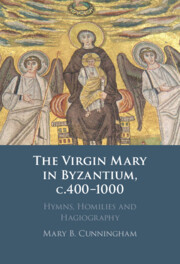69 results
Dedication
-
- Book:
- The Virgin Mary in Byzantium, <i>c</i>.400–1000
- Published online:
- 20 August 2022
- Print publication:
- 08 September 2022, pp v-vi
-
- Chapter
-
- You have access
- Open access
- HTML
- Export citation
A Note on Capitalisation, Spelling and Recent Publications
-
- Book:
- The Virgin Mary in Byzantium, <i>c</i>.400–1000
- Published online:
- 20 August 2022
- Print publication:
- 08 September 2022, pp xii-xii
-
- Chapter
-
- You have access
- Open access
- HTML
- Export citation
Chapter 2 - From Theotokos to Intercessor: The Early Homiletic Witness (c. 400–600)
-
- Book:
- The Virgin Mary in Byzantium, <i>c</i>.400–1000
- Published online:
- 20 August 2022
- Print publication:
- 08 September 2022, pp 67-93
-
- Chapter
-
- You have access
- Open access
- HTML
- Export citation
Acknowledgements
-
- Book:
- The Virgin Mary in Byzantium, <i>c</i>.400–1000
- Published online:
- 20 August 2022
- Print publication:
- 08 September 2022, pp viii-x
-
- Chapter
-
- You have access
- Open access
- HTML
- Export citation
Introduction
-
- Book:
- The Virgin Mary in Byzantium, <i>c</i>.400–1000
- Published online:
- 20 August 2022
- Print publication:
- 08 September 2022, pp 1-35
-
- Chapter
-
- You have access
- Open access
- HTML
- Export citation
Conclusion
-
- Book:
- The Virgin Mary in Byzantium, <i>c</i>.400–1000
- Published online:
- 20 August 2022
- Print publication:
- 08 September 2022, pp 211-218
-
- Chapter
-
- You have access
- Open access
- HTML
- Export citation
Index
-
- Book:
- The Virgin Mary in Byzantium, <i>c</i>.400–1000
- Published online:
- 20 August 2022
- Print publication:
- 08 September 2022, pp 266-276
-
- Chapter
-
- You have access
- Open access
- HTML
- Export citation
Copyright page
-
- Book:
- The Virgin Mary in Byzantium, <i>c</i>.400–1000
- Published online:
- 20 August 2022
- Print publication:
- 08 September 2022, pp iv-iv
-
- Chapter
-
- You have access
- Open access
- HTML
- Export citation
Contents
-
- Book:
- The Virgin Mary in Byzantium, <i>c</i>.400–1000
- Published online:
- 20 August 2022
- Print publication:
- 08 September 2022, pp vii-vii
-
- Chapter
-
- You have access
- Open access
- HTML
- Export citation
Chapter 5 - Narratives about the Panagia
-
- Book:
- The Virgin Mary in Byzantium, <i>c</i>.400–1000
- Published online:
- 20 August 2022
- Print publication:
- 08 September 2022, pp 179-210
-
- Chapter
-
- You have access
- Open access
- HTML
- Export citation
Chapter 1 - Praise of Mary in Song: The Early Hymnography
-
- Book:
- The Virgin Mary in Byzantium, <i>c</i>.400–1000
- Published online:
- 20 August 2022
- Print publication:
- 08 September 2022, pp 36-66
-
- Chapter
-
- You have access
- Open access
- HTML
- Export citation
Additional material
-
- Book:
- The Virgin Mary in Byzantium, <i>c</i>.400–1000
- Published online:
- 20 August 2022
- Print publication:
- 08 September 2022, pp xi-xi
-
- Chapter
-
- You have access
- Open access
- HTML
- Export citation
Chapter 4 - Theology in Verse: Middle Byzantine Hymnography
-
- Book:
- The Virgin Mary in Byzantium, <i>c</i>.400–1000
- Published online:
- 20 August 2022
- Print publication:
- 08 September 2022, pp 137-178
-
- Chapter
-
- You have access
- Open access
- HTML
- Export citation
Chapter 3 - Panegyrics and Supplication: Homilies from c. 600 to 1000
-
- Book:
- The Virgin Mary in Byzantium, <i>c</i>.400–1000
- Published online:
- 20 August 2022
- Print publication:
- 08 September 2022, pp 94-136
-
- Chapter
-
- You have access
- Open access
- HTML
- Export citation
Bibliographies
-
- Book:
- The Virgin Mary in Byzantium, <i>c</i>.400–1000
- Published online:
- 20 August 2022
- Print publication:
- 08 September 2022, pp 219-265
-
- Chapter
-
- You have access
- Open access
- HTML
- Export citation

The Virgin Mary in Byzantium, c.400–1000
- Hymns, Homilies and Hagiography
-
- Published online:
- 20 August 2022
- Print publication:
- 08 September 2022
-
- Book
-
- You have access
- Open access
- Export citation
Chapter 2 - From Theotokos to Intercessor: The Early Homiletic Witness (c. 400–600)
-
- Book:
- The Virgin Mary in Byzantium, c.400-1000
- Published online:
- 29 October 2021
- Print publication:
- 11 November 2021, pp 67-93
-
- Chapter
- Export citation
Chapter 4 - Theology in Verse: Middle Byzantine Hymnography
-
- Book:
- The Virgin Mary in Byzantium, c.400-1000
- Published online:
- 29 October 2021
- Print publication:
- 11 November 2021, pp 137-178
-
- Chapter
- Export citation
Conclusion
-
- Book:
- The Virgin Mary in Byzantium, c.400-1000
- Published online:
- 29 October 2021
- Print publication:
- 11 November 2021, pp 211-218
-
- Chapter
- Export citation
Chapter 3 - Panegyrics and Supplication: Homilies from c. 600 to 1000
-
- Book:
- The Virgin Mary in Byzantium, c.400-1000
- Published online:
- 29 October 2021
- Print publication:
- 11 November 2021, pp 94-136
-
- Chapter
- Export citation



